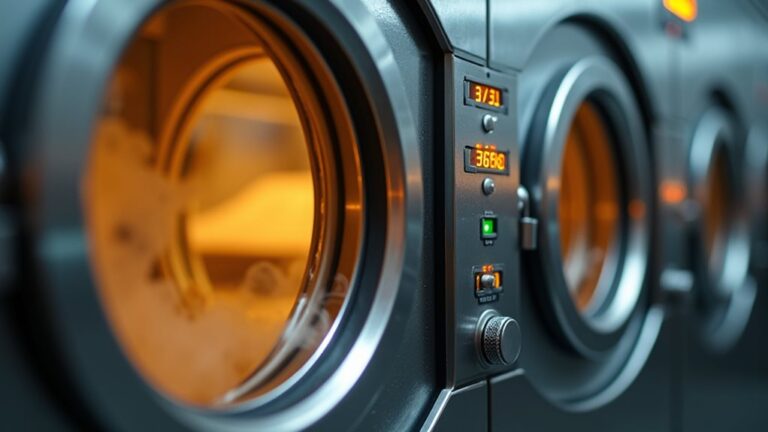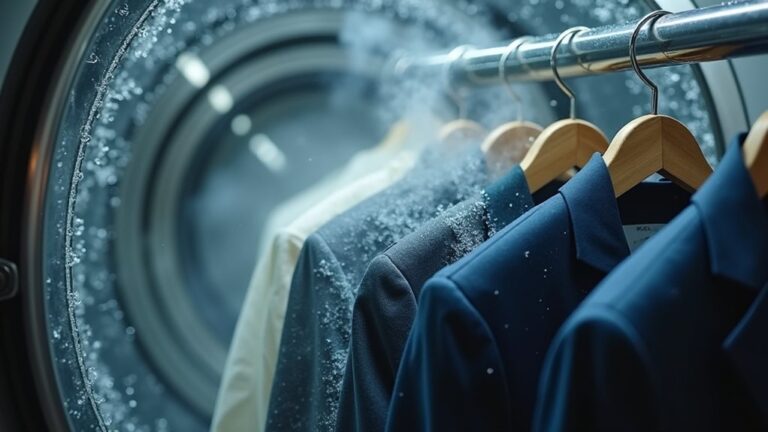When you drop off your delicate silk blouse at the dry cleaner, you’re trusting them with a fascinating chemical process that swaps water for specialized solvents like perchloroethylene to lift stubborn oil-based stains without shrinking or distorting your precious fabrics. Your garment gets inspected, pre-treated for specific stains, then gently bathed in these chemical solvents before receiving professional pressing and steaming that’ll make it look fresh from the boutique—and there’s so much more happening behind those swinging doors.
What Is Dry Cleaning?
Despite its name being somewhat misleading, dry cleaning isn’t actually “dry” at all—it’s more like giving your clothes a luxurious spa day in liquid that isn’t water.
When you drop off that silk blouse or wool suit, you’re fundamentally handing over your precious garments to professionals who understand that some fabrics need special treatment.
The dry cleaning process uses chemical solvents instead of water, which makes all the difference for delicate materials that would shrink, fade, or lose their shape in your washing machine at home.
Think of the solvent as a gentle superhero that swoops in to remove stubborn stains while treating your clothes with the regard they deserve—no harsh agitation or temperature extremes here! 😊
The most commonly used solvent is perchloroethylene, though many cleaners are now switching to newer eco-friendly alternatives for environmental reasons.
Types of Solvents Used in Dry Cleaning
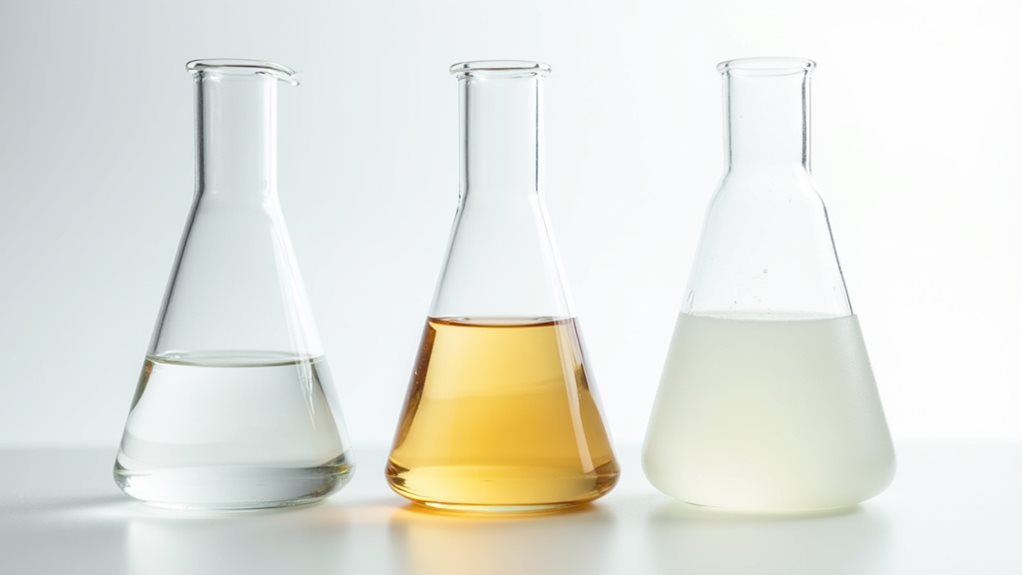
When you peek behind the curtain of your local dry cleaner, you’ll discover a fascinating world where different solvents work like specialized tools in a craftsman’s workshop, each designed for specific cleaning challenges that regular water simply can’t handle.
The traditional heavyweight champion among solvents used has been perchloroethylene (or “perc” as insiders call it), which tackles oil-based stains like nobody’s business but carries some serious health baggage.
Perc remains the go-to stain fighter for tough oils, but its health risks have cleaners searching for safer alternatives.
Another chlorinated solvent that was historically used in the industry was 1,2-dichloroethane, but it has been largely phased out due to its classification as a probable human carcinogen and environmental contamination risks.
Thankfully, today’s cleaners are embracing environmentally friendly solvents like silicone-based solutions and liquid carbon dioxide – think of them as the kinder, gentler cousins who still get the job done without the drama.
These newer alternatives prove you don’t need harsh chemicals to achieve spotless results!
The Step-by-Step Dry Cleaning Process
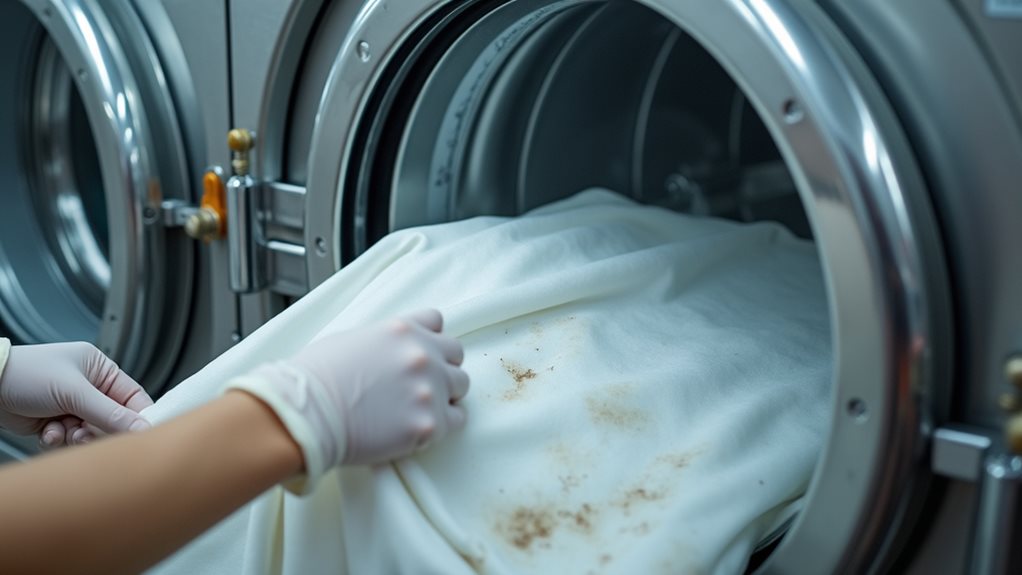
When you drop off your favorite silk blouse or wool suit, you’re probably curious about what actually happens behind those mysterious dry cleaning counter doors. Honestly, I used to wonder the same thing until I befriended my local cleaner who walked me through their meticulous process.
The expedition your garments take involves three essential stages that transform wrinkled, stained clothes back into the crisp, fresh pieces you love: a thorough inspection and tagging system that catches every detail, the actual solvent cleaning process that works like magic on stubborn stains, and finally the finishing touches that make everything look professionally pressed.
Unlike traditional washing, this process uses chemical solvents like perchloroethylene that can dissolve oils and dirt without water, making it perfect for delicate fabrics that would be damaged by conventional washing methods.
Trust me, once you understand these steps, you’ll appreciate why that extra day or two for proper dry cleaning is absolutely worth the wait for perfect results.
Garment Inspection and Tagging
Before your precious blazer or favorite dress disappears into the mysterious world of dry cleaning machinery, it undergoes a surprisingly thorough examination that’s honestly more detailed than most people’s annual physical checkups 😊.
During garment inspection, experienced employees scrutinize every inch of fabric, hunting for stains, checking pockets for forgotten treasures like crumpled receipts or loose change, and documenting any existing damage that might affect the cleaning process.
Each piece receives its own identification tag, creating a personalized tracking system that follows your garment through every step.
This meticulous inspection determines which stains need specialized pre-treatment, because different stains require different removal agents—think of it as prescribing the right medicine for each fabric ailment, guaranteeing your clothes receive the precise care they deserve.
The inspection process is particularly crucial for identifying delicate fabrics like silk and wool that require gentle handling throughout the specialized solvent-based cleaning process.
Solvent Cleaning Process
After your garments have been thoroughly inspected and tagged, they commence on what I like to call their “spa day expedition” through the actual solvent cleaning process, which honestly feels like watching a carefully choreographed dance between chemistry and machinery.
Your clothes tumble gently inside specialized machines filled with dry cleaning solvents, typically perchloroethylene, that work like microscopic magnets pulling away dirt and stubborn stains I’ve battled for years.
The cleaning process involves this mesmerizing tumbling action that’s surprisingly gentle—think washing machine meets meditation session.
What truly amazes me is the solvent recovery system that recycles 99.99% of the solvent, making this surprisingly eco-friendly considering we’re dealing with chemical cleaning agents.
Following the cleaning cycle, your garments undergo solvent extraction and drying, preparing them for the final pressing and steaming stages that restore their crisp, professional appearance.
Finishing and Pressing
Once your freshly cleaned garments emerge from their solvent bath, they’re ready for what I consider the most transformative part of the entire process—the finishing and pressing stage that literally brings your clothes back to life.
Your items undergo a thorough inspection, where trained eyes catch any stubborn stains that might’ve survived the initial cleaning (trust me, it happens!).
Next comes the steaming process, which removes wrinkles while restoring your garments’ natural shape and texture.
The pressing stage follows, using specialized equipment that applies precise heat and pressure to eliminate every crease, guaranteeing that crisp, professional appearance you’re paying for.
This meticulous finishing process includes quality control checks to ensure every garment meets professional standards before being returned to customers.
Finally, your clothes are wrapped in protective plastic bags, though you’ll want to remove those promptly at home to prevent moisture buildup.
Benefits and Advantages of Dry Cleaning
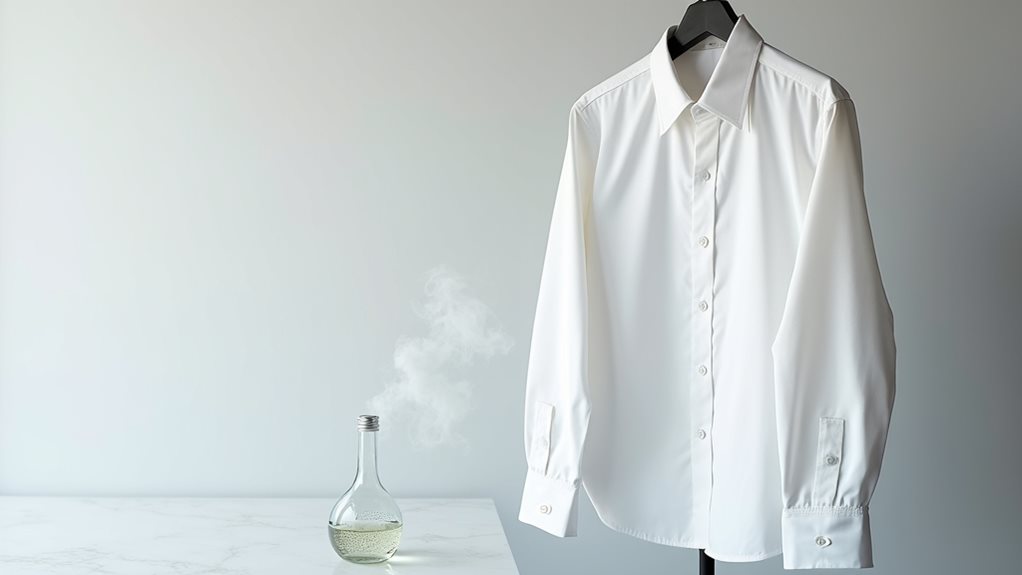
Now that you understand how the dry cleaning process works, you’ll appreciate why it’s become my go-to solution for keeping my favorite clothes looking their absolute best, particularly when regular washing just won’t cut it.
The gentle treatment your garments receive protects delicate fabrics from the harsh agitation and heat that can turn your silk blouse into an expensive rag, while the specialized solvents tackle those stubborn wine stains that made you panic at last month’s dinner party.
You’re fundamentally getting professional-grade results that preserve your clothing’s original shape, color, and texture – something I learned the hard way after shrinking my wool sweater in the washing machine! 😅
This method is particularly crucial for formal wear like suits and evening dresses, where maintaining the garment’s structure and appearance is essential for looking polished and professional.
Gentle Fabric Protection
When you’ve invested in that gorgeous silk blouse or luxurious cashmere sweater, the last thing you want is to watch it transform into a shrunken, misshapen shadow of its former self after a trip through your washing machine.
That’s where gentle fabric protection through dry cleaning becomes your wardrobe’s best friend. Unlike water-based washing that can wreak havoc on delicate fabrics, chemical solvents work their magic without causing shrinkage or distortion.
Here’s how dry cleaning protects your precious garments:
- Preserves original shape and texture of silk, cashmere, and wool
- Prevents shrinking that destroys expensive clothing investments
- Maintains fabric integrity through solvent-based cleaning methods
- Removes stubborn oil-based stains water can’t tackle
- Extends garment lifespan by avoiding traditional washing damage
Garments with special construction features like structured blazers, beaded items, or complex linings particularly benefit from professional dry cleaning to maintain their intricate design elements.
Your designer pieces deserve this level of care!
Superior Stain Removal
Envision this scenario: you’re rushing to get ready for an important dinner, and somehow you manage to drop a glob of foundation right onto your favorite black dress, creating what looks like an impossible-to-remove stain that makes your heart sink.
Here’s where dry cleaning’s superior stain removal capabilities truly shine, offering hope when your washing machine simply can’t deliver the results you need. The chemical solvent used in professional cleaning penetrates deep into fabric fibers, dissolving oil-based stains like makeup, grease, and perspiration that water-based methods leave behind.
What’s particularly impressive is how modern facilities utilize advanced solvent recovery systems, recapturing nearly 100% of cleaning chemicals while guaranteeing your garments receive thorough, gentle treatment that preserves both fabric integrity and your peace of mind. Beyond stain removal, dry cleaning prevents fabric distortion that commonly occurs with traditional washing methods, helping maintain the original shape and structure of your clothing.
Professional Quality Results
Beyond simply removing stubborn stains, professional dry cleaning delivers results that transform your wardrobe from “good enough” to genuinely impressive, giving you that confidence boost that comes from knowing your clothes look absolutely their best.
The dry cleaning process tackles those persistent stains that water-based washing simply can’t handle, while preserving your garment’s integrity through careful attention to detail.
Here’s what makes professional quality results so remarkable:
- Deep inspection and pre-treatment guarantees every stain gets personalized attention
- Delicate fabrics like silk maintain their original texture and vibrant colors
- Professional pressing creates crisp lines that home irons struggle to achieve
- Oil and grease disappear completely, something your washing machine can’t promise
- Expert finishing techniques restore that “fresh from the store” appearance 🌟
You’ll notice the difference immediately – it’s like having a personal stylist for your clothes.
Unlike traditional washing methods, dry cleaning uses chemical solvents instead of water, which prevents shrinkage and color bleeding while effectively cleaning your most valuable garments.
Limitations and Drawbacks of Dry Cleaning
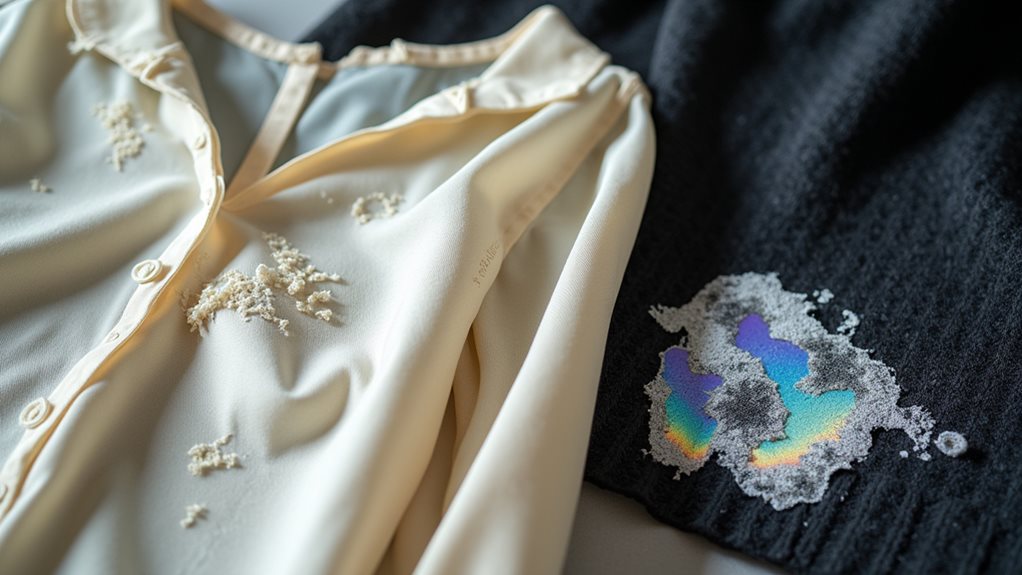
Although dry cleaning has earned its reputation as the go-to solution for delicate fabrics, it’s not without its fair share of limitations that might surprise you.
You’ll discover that water-based stains, like coffee spills or sweat marks, often resist traditional dry cleaning solvents, leaving you frustrated with lingering odors and discoloration.
I’ve learned the hard way that sequined dresses and plastic-based materials can literally melt under harsh chemical treatments – certainly not the glamorous outcome you’re hoping for! 😅
The environmental concerns surrounding perchloroethylene are truly troubling, affecting both workers and your community’s air quality.
Plus, you’ll pay considerably more than home washing, and sometimes stubborn stains require multiple rounds of treatment, making your wallet notably lighter.
Which Fabrics Require Dry Cleaning
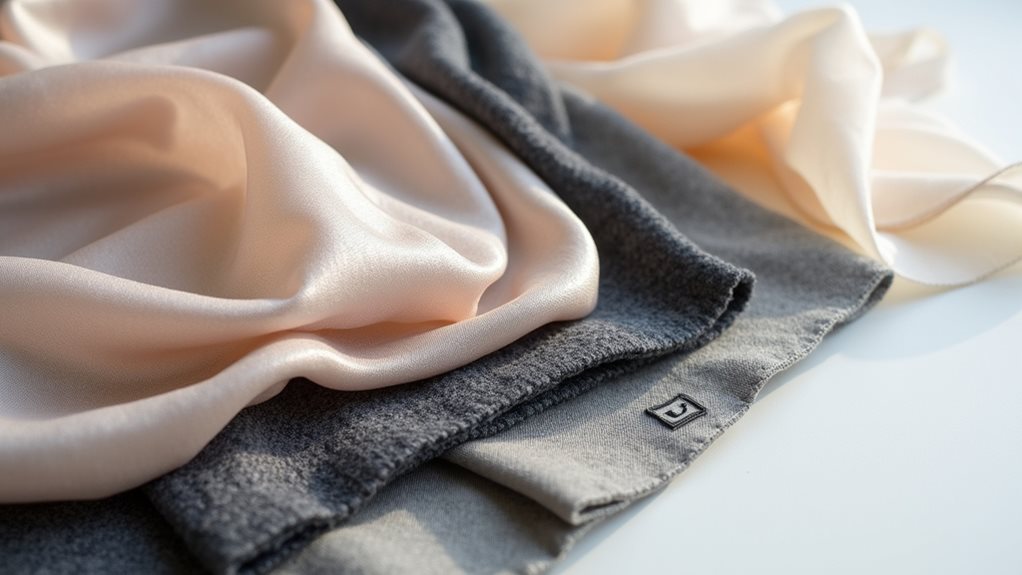
When you’re standing in your closet, holding that gorgeous silk blouse or luxurious cashmere sweater, you’re actually handling fabrics that demand special attention – and I’ve learned this lesson through some rather expensive mistakes! 😬
These natural protein fibers, including wool and silk, contain delicate structures that react poorly to water, causing them to shrink, lose their shape, or develop that dreaded “felted” texture that makes your favorite sweater look like it belongs on a toddler.
Beyond these obvious candidates, several other delicate fabrics absolutely require dry cleaning:
- Velvet and suede that lose their luxurious texture when exposed to water
- Rayon blends prone to dramatic shrinkage and color bleeding
- Embellished pieces with sequins or beads that could detach
- Structured garments like customized suits needing shape preservation
- Lined dresses requiring professional care for proper layer alignment
Environmental Impact and Eco-Friendly Alternatives
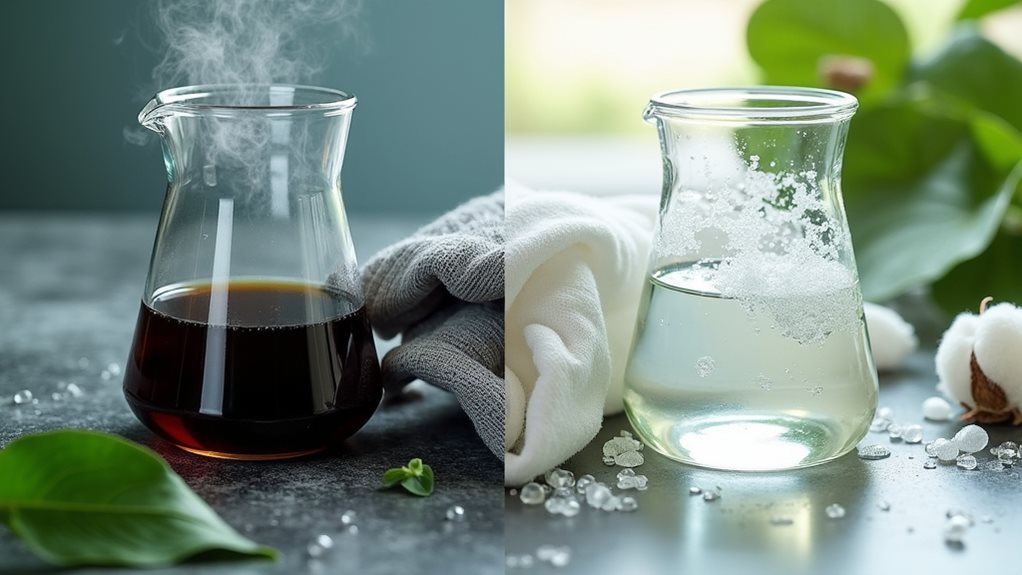
While researching this article, I discovered something that honestly made my stomach turn – the traditional dry cleaning industry has been quietly polluting our environment for decades with a chemical called perchloroethylene, or “perc” as it’s known in the business.
This toxic solvent doesn’t just disappear after cleaning your favorite blazer; it contaminates groundwater, contributes to air pollution, and poses serious health risks to workers who handle it daily.
Thankfully, you’ve got eco-friendly alternatives that are revolutionizing the industry! Liquid carbon dioxide cleaning, silicone-based solvents, and even innovative wet cleaning methods using special detergents can tackle delicate fabrics without the environmental baggage.
These sustainable options, combined with energy-efficient machines that recycle solvents, prove that environmental sustainability and spotless clothes can absolutely coexist. 🌱
Getting the Best Results From Professional Dry Cleaners
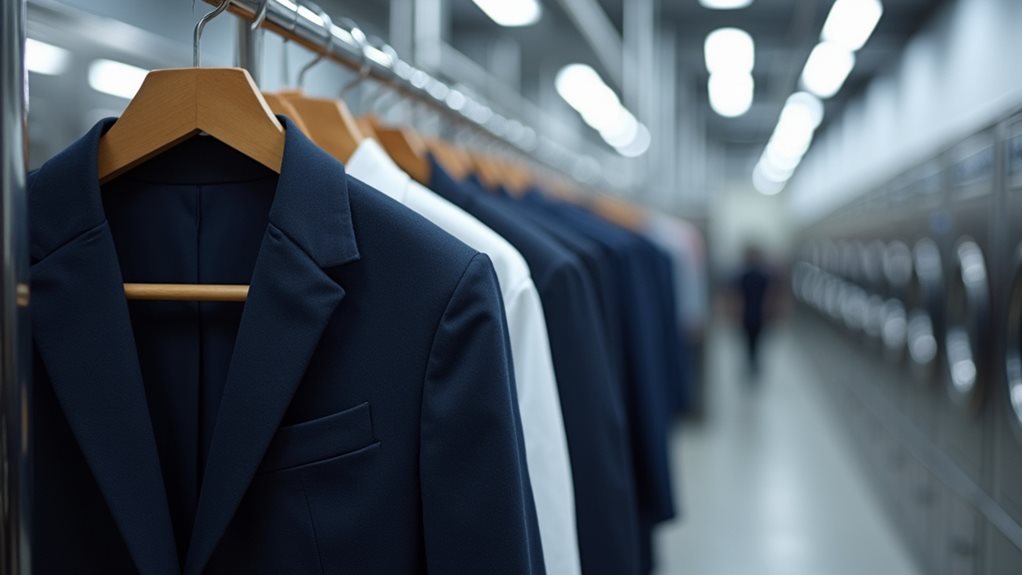
Five simple strategies can transform your dry cleaning experience from a frustrating gamble into consistently stellar results that’ll make you wonder why you ever stressed about those delicate garments in the first place.
Understanding what dry cleaners use and their cleaning methods empowers you to communicate effectively about your precious pieces.
Knowledge is power when it comes to your wardrobe – understanding dry cleaning processes helps you advocate for your garments like a pro.
Here’s your roadmap to dry cleaning success:
- Check garment care labels religiously – they’re your fabric’s instruction manual, not suggestions
- Pre-treat and point out stains immediately – playing hide-and-seek with wine spills never ends well 😅
- Research your cleaner’s experience with delicate fabrics and ask about eco-friendly solvents
- Ensure proper tagging and keep receipts – because nobody wants a “where’s my cashmere?” mystery
- Use professional cleaning regularly to extend garment life and preserve those investment pieces you adore


